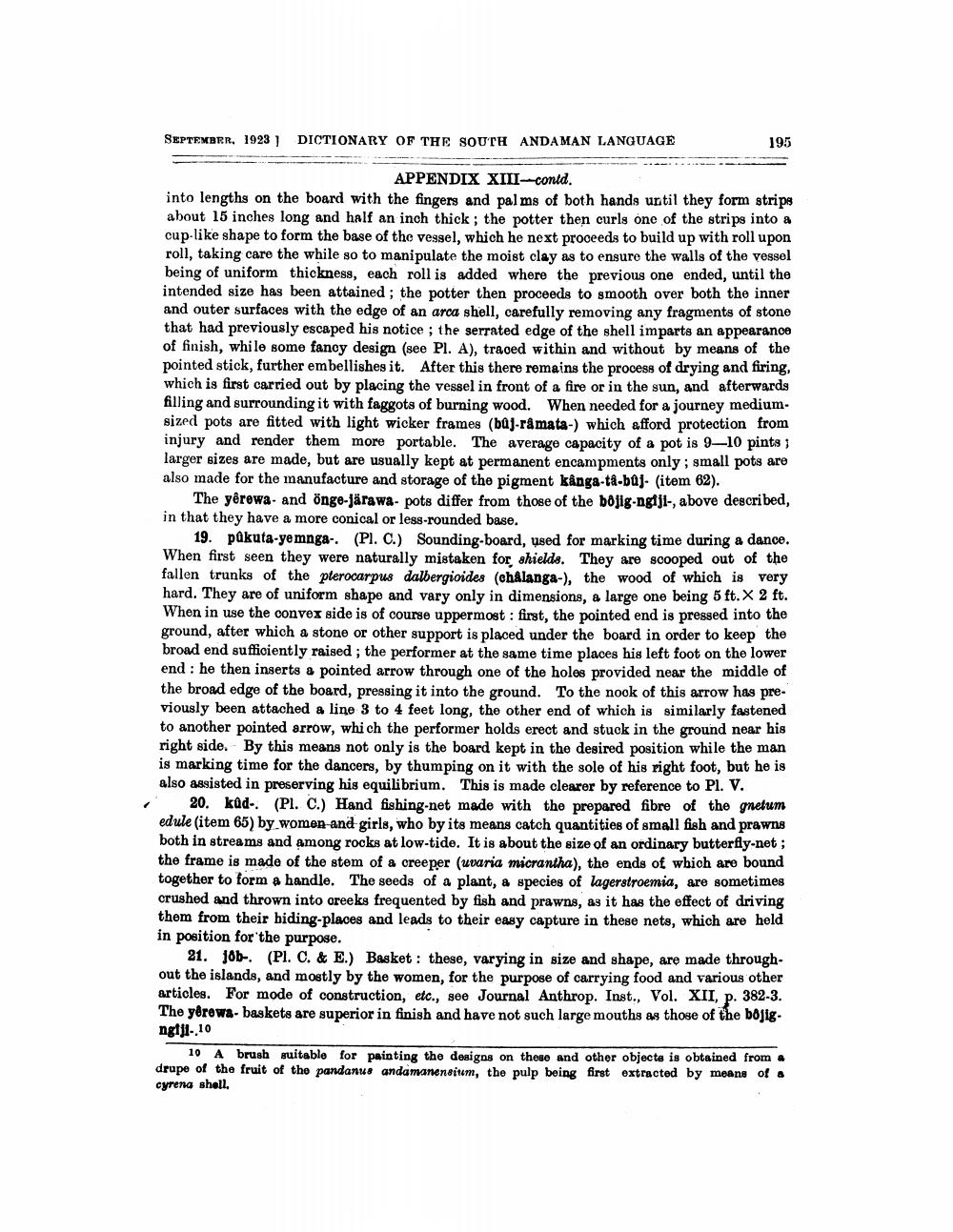________________
SEPTEMBER, 1923] DICTIONARY OF THE SOUTH ANDAMAN LANGUAGE
APPENDIX XIII-contd.
into lengths on the board with the fingers and palms of both hands until they form strips about 15 inches long and half an inch thick; the potter then curls one of the strips into a cup-like shape to form the base of the vessel, which he next proceeds to build up with roll upon roll, taking care the while so to manipulate the moist clay as to ensure the walls of the vessel being of uniform thickness, each roll is added where the previous one ended, until the intended size has been attained; the potter then proceeds to smooth over both the inner and outer surfaces with the edge of an arca shell, carefully removing any fragments of stone that had previously escaped his notice; the serrated edge of the shell imparts an appearance of finish, while some fancy design (see Pl. A), traced within and without by means of the pointed stick, further embellishes it. After this there remains the process of drying and firing, which is first carried out by placing the vessel in front of a fire or in the sun, and afterwards filling and surrounding it with faggots of burning wood. When needed for a journey mediumsized pots are fitted with light wicker frames (bûj-râmata-) which afford protection from injury and render them more portable. The average capacity of a pot is 9-10 pints; larger sizes are made, but are usually kept at permanent encampments only; small pots are also made for the manufacture and storage of the pigment kânga-tâ-bûj- (item 62).
195
The yêrewa- and önge-järawa- pots differ from those of the bojig-ngiji-, above described, in that they have a more conical or less-rounded base.
19. pûkuta-yemnga-. (Pl. C.) Sounding-board, used for marking time during a dance. When first seen they were naturally mistaken for shields. They are scooped out of the fallen trunks of the pterocarpus dalbergioides (châlanga-), the wood of which is very hard. They are of uniform shape and vary only in dimensions, a large one being 5 ft. X 2 ft. When in use the convex side is of course uppermost : first, the pointed end is pressed into the ground, after which a stone or other support is placed under the board in order to keep the broad end sufficiently raised; the performer at the same time places his left foot on the lower end: he then inserts a pointed arrow through one of the holes provided near the middle of the broad edge of the board, pressing it into the ground. To the nook of this arrow has previously been attached a line 3 to 4 feet long, the other end of which is similarly fastened to another pointed arrow, which the performer holds erect and stuck in the ground near his right side. By this means not only is the board kept in the desired position while the man is marking time for the dancers, by thumping on it with the sole of his right foot, but he is also assisted in preserving his equilibrium. This is made clearer by reference to Pl. V.
20. kûd-. (Pl. C.) Hand fishing-net made with the prepared fibre of the gnetum edule (item 65) by women and girls, who by its means catch quantities of small fish and prawns both in streams and among rocks at low-tide. It is about the size of an ordinary butterfly-net; the frame is made of the stem of a creeper (uvaria micrantha), the ends of which are bound together to form a handle. The seeds of a plant, a species of lagerstroemia, are sometimes crushed and thrown into creeks frequented by fish and prawns, as it has the effect of driving them from their hiding-places and leads to their easy capture in these nets, which are held in position for the purpose.
21. job. (Pl. C. & E.) Basket: these, varying in size and shape, are made throughout the islands, and mostly by the women, for the purpose of carrying food and various other articles. For mode of construction, etc., see Journal Anthrop. Inst., Vol. XII, p. 382-3. The yêrewa- baskets are superior in finish and have not such large mouths as those of the bojig. ngtji-.10
10 A brush suitable for painting the designs on these and other objects is obtained from a drupe of the fruit of the pandanus andamanensium, the pulp being first extracted by means of a cyrena shell,




